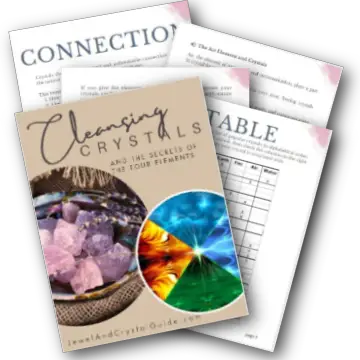Citrine and yellow topaz are both beautiful yellow crystals, but they do have some big differences between them…
Citrine is a yellow quartz crystal that forms in six-sided hexagonal prisms, like a honeycomb. Yellow topaz is a silicate crystal with long prisms that have straight sides meeting at right angles.
Let’s explore what makes citrine so different from yellow topaz, so you can tell one from the other.
In this blog post, you’ll discover:
- The differences between citrine and yellow topaz
- A table summarizing the differences between citrine and yellow topaz
The differences between citrine and yellow topaz
Here’s a list of differences between citrine and yellow topaz…
Citrine is quartz, yellow topaz is a silicate
Citrine and yellow topaz are completely different crystals.
Citrine is a yellow quartz crystal that gets its color from iron impurities in the crystal. Yellow topaz is an aluminum silicate fluoride crystal, and it usually gets its color from a flaw in the crystal’s structure.
Let’s dig into the nitty gritty of what these crystals are made of and how they get their color.
Citrine is made up of silicon and oxygen, like all quartz crystals.

Pure quartz is colorless or white, but small amounts of other elements, called impurities, can color quartz under certain conditions.

As soon as quartz gets a color, it is given another name. For example, purple quartz is called amethyst and brown or black quartz is called smoky quartz.
In nature, citrine is often found with amethyst or smoky quartz. In fact, citrine is amethyst or smoky quartz that got hot. The heat turned small amounts of iron in the crystal yellow, to create citrine.
Topaz is made up of aluminum, silicon, oxygen, fluorine, and hydroxide.
Impurities can turn topaz different colors, but experts don’t think this is how yellow topaz forms. Most researchers agree that topaz is yellow because of defects or abnormalities in its structure.
Citrine and yellow topaz form in different shapes
There are seven crystal systems, and all crystals fall under one of these systems.
Citrine has a trigonal crystal system, and it usually forms in six-sided hexagonal prisms, much like a honeycomb pattern. Each prism’s ends (terminations) join together at the tip to look like a pyramid.

Yellow topaz falls under the orthorhombic crystal system, and it forms long crystals in the shape of a prism. The sides of each prism can be different lengths, but all sides meet at right angles.
An example of this structure is a rectangular prism, like a shoebox. The sides of the shoebox are all straight and meet each other at right angles, but the lengths of the sides are not all the same (two shorter sides and two longer sides).
That’s how crystals in the orthorhombic system often look – they have straight sides forming right angles, but the sides can be different lengths.

Citrine and yellow topaz come from different countries
Natural citrine is rare, even though it’s found in several countries. Most natural citrine comes from Brazil, Bolivia, and Madagascar.
Most citrine on the market is man-made, which I wrote about in this article comparing natural and man-made citrine, and whether man-made citrine is real citrine or not.
Yellow topaz is not rare and is quite widely available. Most yellow topaz comes from Brazil, Russia, and Sri Lanka.
Citrine and yellow topaz break in different ways
Both citrine and yellow topaz break under enough pressure – but how they break is very different.
Citrine is a quartz crystal. Quartz is quite special as it has the same strength throughout the crystal, which means it does not break along clear, straight lines.
Under some pressure, quartz starts fracturing. These fractures randomly spread through the quartz, without any parallel groups of cracks.
Keep adding pressure and the crystal finally breaks…
But when quartz breaks, it forms curved, shell-like surfaces, a bit like how the bottom of a glass bottle breaks. We call this a “conchoidal fracture.”

To understand how topaz breaks, we need to understand cleavage. Cleavage planes are weak paths where crystals tend to break more easily.
Cleavage planes are kind of like the pre-marked lines in a slab of chocolate. As soon as you put pressure on the chocolate, it’s likely to break along those lines. The same thing happens with crystals that have cleavage planes, though we can’t see the planes.
Yellow topaz has well-developed cleavage planes: If you apply enough force to the crystal, it breaks in straight lines along its lines of weakness.
Yellow topaz is slightly harder than citrine
We measure the hardness of minerals on the Mohs scale from 1 to 10. Minerals that are high on the scale are harder than softer minerals that fall lower on the scale.
Citrine is a 7 on the Mohs scale and yellow topaz is an 8. This means that yellow topaz is slightly harder than citrine, making topaz a bit more durable and resistant to scratches even though both are very strong crystals.
To give you an idea of how hard they are, citrine and topaz are both rated as harder than copper and steel.
This info might come in handy if you want to know if you have citrine or yellow topaz in your hands. You see, minerals can scratch softer minerals and minerals with the same hardness rating, but minerals can’t scratch other minerals that are harder than them.
If you want to test if a crystal is topaz or quartz, try scratching it in an inconspicuous place with a piece of quartz. If you see scratches on the surface of the crystal, even if it’s with a magnifying glass, then you probably have citrine.
If you can’t scratch the crystal with your quartz, then it’s likely to be citrine or another hard yellow mineral.
Citrine bends light less than yellow topaz
You know how a straw looks bent when you put it in a glass of water? Well, light bends like this too when it moves from one material to another.
In fact, we can measure how much light bends when it passes through things like crystals. And because crystals are made up of different materials, light bends differently with different crystals.
The refractive index measures how much light bends or changes direction when it passes through something. The higher the refractive index of a material, the more light bends, and the lower the refractive index of a material, the less light bends.
Citrine has a refractive index of about 1.54 to 1.56. Yellow topaz has a slightly higher refractive index, from about 1.61 to 1.64. So citrine bends light a little bit, but yellow topaz bends it a little more.
To accurately measure a crystal’s refractive index and decide which crystal you have, you need to use a gem refractometer. If you don’t want to buy one, contact your local lapidary group or ask a qualified jeweler to take a look for you with their equipment.
Yellow topaz forms rainbows, citrine doesn’t
White light is made up of all seven colors of the rainbow: red, orange, yellow, green, blue, indigo, and violet.
When white light passes through a crystal, it can get split into these colors because different colors bend at slightly different angles. This effect is called dispersion.
Think of how a hanging crystal suncatcher, like this one, scatters colors around a room when sunlight catches it. This is the result of dispersion.
Citrine doesn’t separate the colors in white light as much as yellow topaz does.
Citrine is quartz, which has a relatively low dispersion. When white light enters citrine, its colors may blend together or show very little separation, so you won’t see rainbows around it.
But when white light enters yellow topaz, it separates and you see a more distinct and vibrant display of colors, similar to a rainbow.
Citrine is for abundance, yellow topaz is for strength
People use crystals to bring them different things.
Citrine brings abundance, success, and positive energy. The crystal is associated with joy and optimism, helps with goal-setting, and enhances creativity and imagination.
Charge citrine and keep it on your body, in your purse or wallet, or in a dreamcatcher for the best results.
Yellow topaz is associated with strength, courage, healing, and protection. The crystal enhances mental clarity, helps with decision-making and problem-solving, and has a calming and balancing effect on emotions.
Table of differences between citrine and yellow topaz
The table below is a quick guide to all the differences between citrine and yellow topaz that I explained in detail above:
| Property | Citrine | Yellow topaz |
| Composition | Quartz crystal | Silicate |
| Crystal shapes | Six-sided hexagonal prisms | Straight sides of different lengths meeting at right angles to form prisms |
| Origin | Brazil, Bolivia, and Madagascar | Brazil, Russia, and Sri Lanka |
| Breaks under pressure | Conchoidal fractures that look like shells | Breaks off in straight lines |
| Mohs scale | 7 | 8 |
| Refractive index | 1.54 to 1.56 | 1.61 to 1.64 |
| Dispersion | No rainbow-like effects | Rainbow-like effects |
| Good for | Abundance, success, and positive energy | Strength, courage, healing, and protection |











